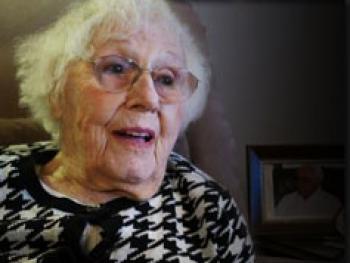Mary Misetich

Tuna Pioneers: San Pedro-Terminal Island, California
In the early 1900's, the West Coast tuna industry was born in the small coastal California town of San Pedro, near Los Angeles. Fishing and canning businesses soon expanded to nearby Terminal Island developing into a multi-million dollar industry. At the heart of it all was a thriving immigrant community. Generations of immigrants primarily from Japan, Croatia, and Italy harvested tuna, supported the bustling fish markets, and worked in the canneries. They explored new fishing grounds and developed novel fishing and preservation methods that influenced the global tuna industry today. Though the large tuna fleet and canneries are now gone from the area, many of those who were involved still reside there. The interviews in this collection were conducted as part of an effort to create a short film about this history.
Mary Misetich was born in 1912 in Washington. Her family later moved to San Pedro, where she lived for 90 years. In 1932, she married Dominick Misetich, a tuna fisherman. Both of their families came from the island of Brac, Yugoslavia.
Dominick was part of a prominent San Pedro fishing family. He and his brother, Anton, sons of Jakov Misetich, owned the fishing vessels Ronny M, Lucky Star, Liberator, Dolores M, and the Anthony M. Jakov purchased the Lucky Star from Starkist. He paid it off in fish, repeating the process with his sons until the family owned a fleet of fishing vessels. The F/V Anthony M, run by Anton, was an industry legend for being the first to use nylon seine netting in 1956; and the brothers continued to pioneer this technology. The net was made with 10,000 lbs. of DuPont filament nylon by A. M. Starr Net Company. Anton is also credited with developing the “back-down” procedure, which along with the Medina Panel developed by San Diego Captain Harold Medina, greatly reduced dolphin deaths in tuna purse seine nets.
Mary worked in a tuna cannery for a short time. Later, she became financial officer in the family business. She was bookkeeper and accountant, wrote paychecks and checks for supplies, bought food for fishing trips, and managed the boats. The Misetich’s business had numerous employees; they were responsible for the livelihoods of many San Pedro families.
Mary had three children. With the men at sea so often, Mary and her two sisters and sister-in-law raised their children as single parents, for the most part. They lived on the same small block so their children were raised together and remain close to this day.
Mary was also active in the community. She was involved in charitable works through the San Pedro Fisherman’s Women’s Auxiliary and Friends of Brac, and volunteered many years at the San Pedro Peninsula Hospital gift shop. She was very involved in her church, Mary Star of the Sea, where a statue of the Virgin Mary holds a tuna boat safely in her arms.
Mary passed away in San Pedro, the town she loved, at age 100 in February 2013. When asked her secret to a long life, dancing was a part. Her accounts of dancing with Dominick at the recreation club at Royal Palms beach under a full moon that lit up the sea are romantic recollections of San Pedro’s colorful past.
Mary discusses what it was like for the wives of the tuna fishermen in San Pedro. She notes that the wives took care of family duties when the fishermen were at sea, and some balanced this while also working in the tuna canneries. She discusses her concerns for her husband’s safety when he was at sea and a fun tradition they had when the boats departed. She explains that many of the fishermen, who were of Croatian descent, brought their wives over from Croatia. Mary also talks about what she did as the business manager for her husband’s fishing business and what she enjoyed about working in the cannery.
Please Note: The oral histories in this collection are protected by copyright and have been created for educational, research and personal use as described by the Fair Use Doctrine in the U.S. Copyright law. Please reach out Voices@noaa.gov to let us know how these interviews are being used in your research, project, exhibit, etc. The Voices staff can help provide other useful resources related to your inquiry.
The NOAA mission is to understand and predict changes in climate, weather, oceans, and coasts, to share that knowledge and information with others, and to conserve and manage coastal and marine ecosystems and resources. The Voices Oral History Archives offers public access to a wide range of accounts, including historical materials that are products of their particular times, and may contain offensive language or negative stereotypes.
Voices Oral History Archives does not verify the accuracy of materials submitted to us. The opinions expressed in the interviews are those of the interviewee only. The interviews here have been made available to the public only after the interviewer has confirmed that they have obtained consent.
